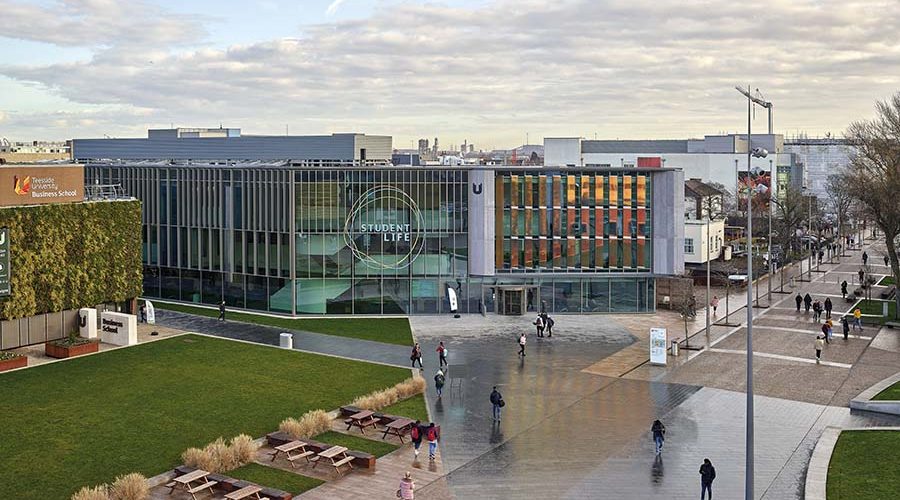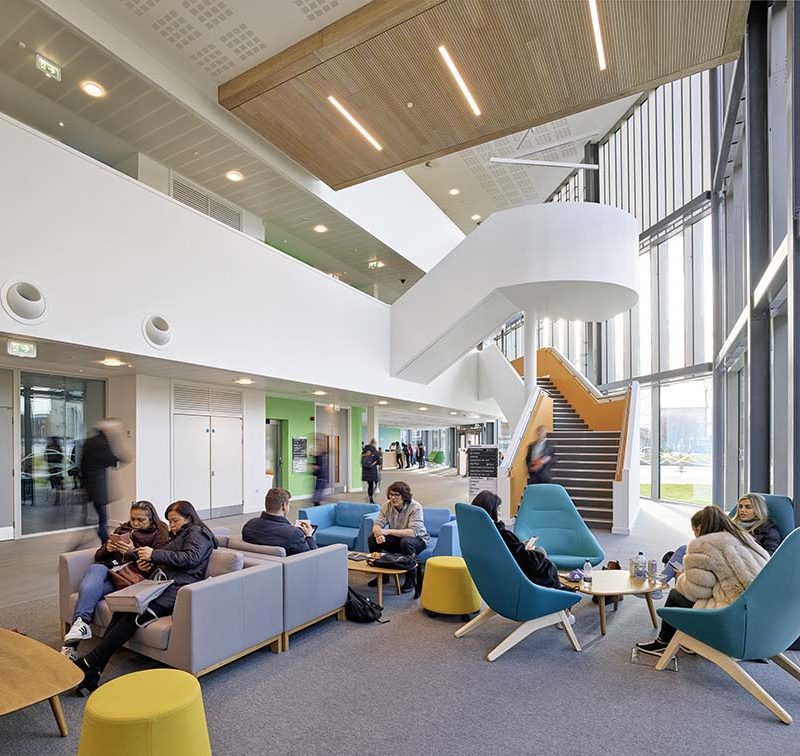With a key aim of Teesside University being to support the mental health and wellbeing of its students, Trevor Trainor, Associate Director of construction and property consultant Summers-Inman – the cost consultant on the university’s recently completed Student Life Building – looks back on its successful delivery.
Summers-Inman
With more than 18,000 students studying at Teesside University at any one time, alongside its academic success, the wellbeing of its students lies at the heart of the university’s culture.
Now, thanks to its new state-of-the-art £13.2m Student Life Building, its ambition to achieve sector-leading student mental health and wellbeing has been translated into a major investment, with the location of this wonderful new building at the core of the university’s expanding Middlesbrough campus.
The project also marks the completion of the latest phase of work to be undertaken as part of the university’s impressive £300m transformational master plan
launched in 2017.
The importance of mental health and wellbeing in higher education
Within the higher education sector, it is widely recognised that there is an urgent and growing need to provide students with mental health and wellbeing support. Doing this enhances their experience of student life as well as supporting them in a more holistic way to achieve academic success.
Designed by architect firm FaulknerBrowns, the 2950m2 three-storey building has provided the university with an innovative facility within which it has amalgamated its student-focused provision, in a highly visible and accessible central location on its Middlesbrough campus.
In addition to allowing the university to refocus its delivery of student support, Student Life also allows it to adopt a one-stop ‘triage’ approach, ensuring that students are directed to the right service as quickly and efficiently as possible, whether this is through physically accessing the building or remotely through the extensive online offer.
The concept of Student Life was borne out of consultation with staff and students undertaken as part of the university’s 10-year masterplan and estates strategy. The inspiration behind the building’s form and function was arrived at following careful consideration of the ‘Five Ways to Wellbeing’ – a set of evidence-based public mental health messages aimed at improving the mental health and wellbeing of the whole population. These were developed by the New Economic Foundation, which resulted from a Government commission as part of the Foresight Project on Mental Capital and Wellbeing. The five ways encourage students and staff to:
• Connect in a wide range of social and collaborative learning environments
• Be active by engaging in activities and using the prominent feature staircase
• Take notice of the university’s full range of opportunities, the campus landscape and the changing appearance of the dichroic glass fins
• Keep learning by engaging with a wide range of skills development and learning opportunities
• Give by engaging in collaborative learning and group workshops.
• Removing the stigma
As well as relocating a multitude of disconnected specialisms, including counselling, careers, faith and reflection, student finance and welfare, wellbeing, IT support along with bookable space and a catering offering into one central location, Student Life is now home to the university’s disability services team. This works with students to develop support plans that go beyond those required for academic purposes such as aspects of everyday life including travel, living arrangements and assistive technology as well as counselling.
The university also operates a regional disability assessment centre which undertakes support needs assessments for both higher and further education applicants on behalf of the DfE, regardless of where they have applied to study.
One key ambition of the building’s design was that it should overcome any stigma that might be felt by students and which may prevent them from seeking support by removing barriers which may discourage access. This has been successfully achieved first and foremost by removing the distinction between ‘learning’ and ‘support’ spaces, providing everything students need outside of the classroom, in one place.
Timber clad pods containing consultation and study rooms have been arranged to create a series of interlocking internal spaces which benefit from not only visual connectivity but also daylight and views, without compromising on privacy. Moreover, the scale of the spaces has been tempered to balance openness and connectivity with the need to create an environment which can be comfortably accessed by students who might be distressed, or those not comfortable in a busy and bustling campus environment.
Flexibility built-in
Speaking about the project, Darren Vipond, Teesside University’s Director of Campus Services, said: “On this latest scheme, we have invested £13.2m to develop a student-centred and student-led space, providing information and services to support, inspire and empower success in learning and life.
“We provide a broad range of support and personal development services to the many students choosing to study at the university, including a growing number of ‘commuter’ and international students as well as those with physical disabilities, learning difficulties or mental health issues.
“It was important that the building was designed to overcome any stigma which may prevent students from seeking support, and I believe it has more than achieved that goal. In addition, the introduction of an Enquiries Management System (EMS) will allow data to be collected that we will use to monitor social outcomes measured against key performance indicators, which is a further demonstration of our commitment to students.”
Student Life has created a technologically enabled environment, supporting a variety of learning styles, activities and attendance patterns. It offers a range of flexible spaces, enabling social and collaborative learning, as well as an information zone, consulting rooms and a cafe.
The design and construction of Student Life has been delivered sustainably, an objective which was embedded in the design process at an early stage. Alongside achieving BREEAM ‘Excellent’, the building has also achieved an EPC ‘A ‘rating.
Early engagement also came from Summers-Inman’s appointment to provide both project management and cost consultancy services, which meant that it was able to drive the project forward from the outset to achieve the client’s aspirations in terms of both programming and quality.
Working to BIM Level 2 facilitated a fully coordinated design and mitigated any possible issues with what otherwise was a complex build for main contractor, Willmott Dixon.
Supporting the local community also played its part in the project, where work was undertaken by an entirely North East-based design and construction team, making a significant contribution to the local economy during the build programme.
Out with the contracts awarded to the local supply chain, 60 weeks of apprenticeships were completed, 10 weeks of work experience were provided, and Willmott Dixon delivered workshops and provided tuition to some 750 students.
The all-round benefit of the building will be felt by Teesside University and its students for many years to come.
Finally, the building’s success can be further measured by the industry recognition it has received with short listings by both RIBA and RICS in their annual award schemes which recognise projects for their positive social impact.












